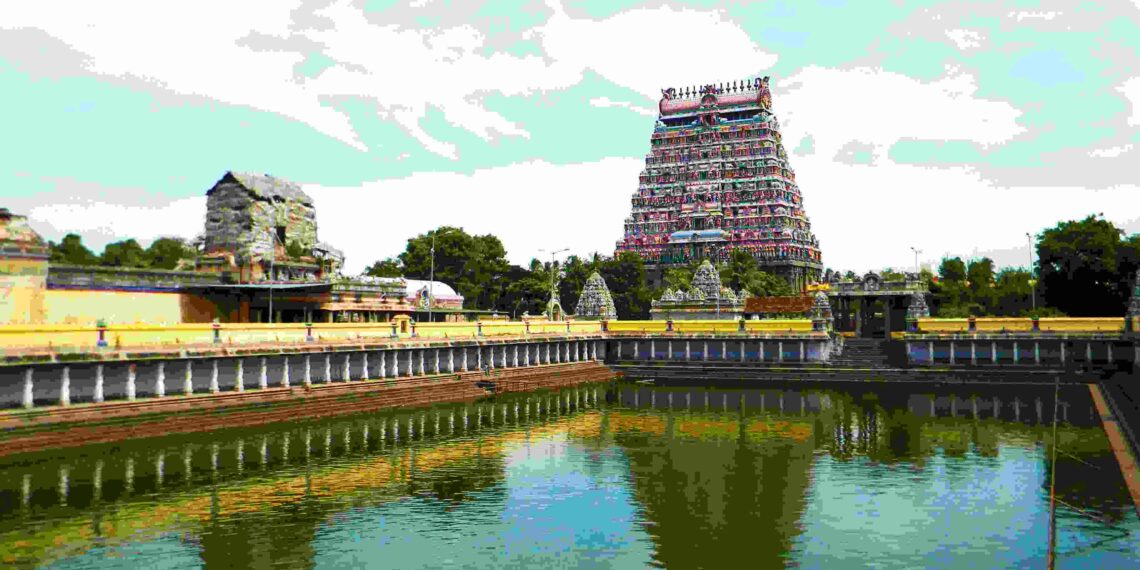The Thillai Nataraja Temple is in Chidambaram, Tamil Nadu, a holy kshetra for Lord Shiva, worshipped as Nataraja, the cosmic dancer. It is one of the Pancha Bhoota Sthalams, linked to the element of ether(Aakasha). Covering 40 acres, its golden-roofed shrine, tall gopurams, and old courtyards bring in pilgrims, scholars, and visitors from all over India. The temple feels alive with didine prayers and the blaze of lamps.
Legend of the Temple
The temple’s story begins with a legend. Long ago, Shiva, as Nataraja, danced his cosmic dance, the Ananda Tandava, in a forest of thillai trees. This dance showed the cycle of creation and destruction. Two sages, Vyaghrapada and Patanjali, wanted to see it. Shiva chose Chidambaram’s sacred grove and danced there, filling the sages with awe. In their devotion, they built a lingam to honor him, which became the temple’s heart.
Another story is the Chidambara Rahasyam, or “secret of Chidambaram.” Behind Nataraja’s idol, a curtain hides an empty space, said to be Shiva’s formless presence, the ether. People believe this emptiness holds the truth of life, and creation.
Detailed History of Thillai Nataraja Temple
The temple’s history goes back to the 6th to 9th centuries. The Tevaram hymns by saints Sambandar, Appar, and Sundarar call it a Paadal Petra Sthalam, a special Shiva shrine. Worship here may have started in the 4th century, but the current temple grew later. The Chola kings, from the 9th to 13th centuries, built much of it, showing their devotion to Shiva.
Chola rulers like Kulothunga I and Rajaraja II gave gold, land, and halls, as stone carvings show. By the 10th century, the temple was a busy center for prayers, learning, and trade, with villages sending food and oil. The golden roof over the Chit Sabha was a Chola gift. The Vijayanagara kings, from the 14th to 16th centuries, added gopurams and carvings. The Nayaks of Thanjavur built detailed pillars.
In the 1300s, northern invaders caused trouble, but priests protected the temple. The Vijayanagara kings later restored it, bringing back rituals. In the 1700s, the French held Chidambaram in 1757, the British in 1760, and Tippu Sultan in 1790. Despite these changes, the temple stayed strong. By 1855, the British managed it, and in 1951, Tamil Nadu’s HR&CE Board took over, keeping its traditions safe.
The temple’s spiritual history shines in the Tevaram and hymns by Manikkavasagar, still chanted here. The Dikshitar priests, tied to the temple for centuries, carry on its rituals.
Architecture of the Temple
The Thillai Nataraja Temple is Dravidian style, covering 40 acres with four gopurams, one for each direction. Each gopuram has carvings of Shiva’s dance, gods, and myths. The eastern gopuram is the largest, welcoming visitors. The others are also detailed.
At the core is the Chit Sabha, its golden roof a beacon, home to Nataraja’s bronze idol, caught mid-dance. The Kanaka Sabha holds the lingam, said to be self-born, and the Chidambara Rahasyam’s curtain hides that sacred emptiness. Shrines for Parvati as Sivakamasundari, Ganesha, and Murugan weave through, each with a quiet grace. The Raja Sabha, a thousand-pillared hall, shines with carvings of dancers and sages, while the Sivaganga tank mirrors the gopurams’ tips. Wall paintings, some from Nayak times, show Shiva’s stories and legends in detail. Shrines for Parvati as Sivakamasundari, Ganesha, and Murugan are scattered around. The Raja Sabha, a thousand-pillared hall, has carvings of dancers and sages. The Sivaganga tank reflects the gopurams. Some wall paintings from Nayak times show Shiva’s stories.
Religious Significance
For Saivites, the temple is a key site, one of the Pancha Bhoota Sthalams, tied to ether. The story of Nataraja’s dance and the Chidambara Rahasyam make it a place to seek deep truth. People pray for wisdom or liberation, offering flowers or joining abhishekam.
As a Paadal Petra Sthalam, it’s a major pilgrimage spot, named in the Tevaram and has a great role in Saiva tradition, shaped by saints and rishis.
Festivals and Rituals
The temple comes alive during festivals. Natyanjali, in February or March, has Bharatanatyam dancers honoring Nataraja. Ani Thirumanjanam and Arudra Darshan bring processions and prayers. Six daily rituals, led by Dikshitar priests, run from morning to night, keeping the temple’s spirit steady.
Cultural and Modern Importance
The temple is a rich heritage of Tamil culture. The Tevaram hymns and Manikkavasagar’s songs began here, shaping Saiva beliefs. Festivals keep Tamil dance and music alive, and the carvings show life from long ago. Today, it draws visitors from all over India. Chidambaram is 230 km from Chennai, reachable by train or bus. It’s a place where Tamil Nadu’s past and present meet, where faith and art still live.
Conclusion
The Thillai Nataraja Temple is not only a temple of Shiva but a living space where the energy of Shiva in his raw form can be tapped through meditation and worship. The dance of Shiva’s form, Nataraja represents the divine ecstasy of creation which is has a deep and significant role in the Saiva tradition. If you want to experience the divine presence of Chidambaram, you must make plans to visit there.











